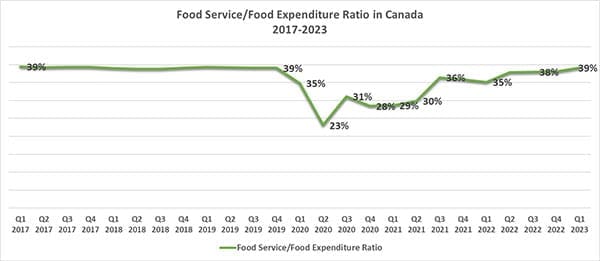Restaurant industry demonstrates robust recovery post-pandemic
 If there’s one sector that deserves some good news, it’s the restaurant industry. This sector has been through hell due to the pandemic, putting our restaurateurs and their employees to the test. However, recently published reports indicate that the restaurant industry is making a strong comeback.
If there’s one sector that deserves some good news, it’s the restaurant industry. This sector has been through hell due to the pandemic, putting our restaurateurs and their employees to the test. However, recently published reports indicate that the restaurant industry is making a strong comeback.
According to a report from Circana, the restaurant industry continued its robust recovery in the first quarter of 2023. Restaurant visits increased by 11 percent, and spending rose by 18 percent during the quarter ending in March compared to the same period last year.
This is great news considering the painful challenges this sector has faced in recent years. Since March 2020, despite higher prices, consumers appear to be visiting restaurants more often.
 Photo by Alex Haney |
| Related Stories |
| The old Tim Hortons we all know is just fading away
|
| How technology is changing the restaurant landscape
|
| How many restaurants do we really need in Canada?
|
According to the Circana report, the increase in visits to food services at different times of the day can be attributed to changing behaviours, such as the gradual return of people to workplaces and engaging in formal or informal routines outside the home. Breakfast and morning snack periods experienced significant growth, with morning meal demand up by 13 percent, representing the largest share of daily traffic. Lunch and dinner visits also grew 10 percent, while afternoon snack demand increased by eight percent compared to the same quarter last year – all very encouraging metrics for the sector.
In summary, full-service restaurants showed the highest growth in traffic, with a remarkable gain of 24 percent. However, quick-service establishments still dominated with a 67 percent share of all food service visits, showing a nine percent increase during the quarter. Full-service establishments accounted for 22 percent of the total visits. The remaining share of traffic represents retail dining, including prepared foods in convenience stores and grocery stores, which experienced a five percent decline compared to the previous year.
No surprise here. The latest results from McDonald’s and Restaurant Brands International, the parent company of Tim Hortons and Popeyes, for example, indicate that the fast-food sector is doing better. This may not be desirable for some, but at least people are going out.
And the good news doesn’t stop there. Statistics Canada also added its two cents last week by mentioning that even though retail food sales have been declining for some time due to persistent food inflation, the percentage of food service, in relation to total food sales, seems to have returned to its pre-pandemic level for the first time. Before the pandemic, the percentage stood at 39 percent. According to Statistics Canada’s data, the percentage in the first quarter reached 39 percent again, a four percent increase from a year ago. In other words, when it comes to dining out, consumers are returning to their pre-pandemic habits.
The restaurant industry remains one of the most important sectors in our economy. If the restaurant industry thrives, so will retail. Restaurants are the ultimate lure for the retail business, enticing people to go out. But according to Statistics Canada, we also observed that the sector generated as much revenue as in the first quarter of 2019 – the last complete pre-pandemic first quarter – but with approximately 100,000 fewer employees in the sector, including accommodation sites.
In short, the data from the restaurant industry is reassuring. Everything indicates that consumers may be going out to forget their despair at the grocery store. Perhaps the “might as well” syndrome is driving people to go out despite wallets still being intimidated by inflation.
Dr. Sylvain Charlebois is senior director of the agri-food analytics lab and a professor in food distribution and policy at Dalhousie University.
For interview requests, click here.
The opinions expressed by our columnists and contributors are theirs alone and do not inherently or expressly reflect the views of our publication.
© Troy Media
Troy Media is an editorial content provider to media outlets and its own hosted community news outlets across Canada.


